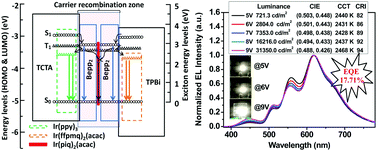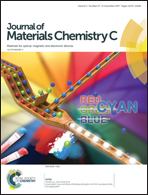Manipulation and exploitation of singlet and triplet excitons for hybrid white organic light-emitting diodes with superior efficiency/CRI/color stability
Abstract
A high performing tetra-chromatic hybrid white organic light-emitting diode (WOLED), with a fluorescent blue emitting layer (EML) of bis[2-(2-hydroxyphenyl)-pyridine]beryllium (Bepp2) sandwiched between a pair of a phosphor-doped hole transporting layer (HTL) and an electron transporting layer (ETL), was developed. This was achieved by controlling the location of the green phosphor doped in the HTL and yellow phosphor doped in the ETL at ∼1 nm away from the HTL/EML and EML/ETL interfaces, and incorporating an ultrathin red phosphorescence layer (<0.1 nm) in the center of the Bepp2 EML. The resulting hybrid WOLED exhibits good warm white emission, showing stable electroluminescence spectra with a maximum color rendering index (CRI) of 94 and a low correlated color temperature of 2440–2468 K over a wide voltage range of 5–9 V. Meanwhile, this WOLED also achieves a high device efficiency, a maximum current efficiency and power efficiency, 29.51 l m W−1 and 17.71%, respectively, and an external quantum efficiency of up to 34.15 cd A−1. Such a high performance is realized through the precise manipulation and effective exploitation of singlet and triplet excitons via a novel device design. Moreover, the proposed WOLED also removes the additional interlayers between the fluorescent and phosphorescent emitting regions that are commonly employed in the conventional hybrid WOLEDs, inducing a simplified device structure with reduced heterojunction interfaces, which is very beneficial for promoting the commercial development of WOLEDs.



 Please wait while we load your content...
Please wait while we load your content...